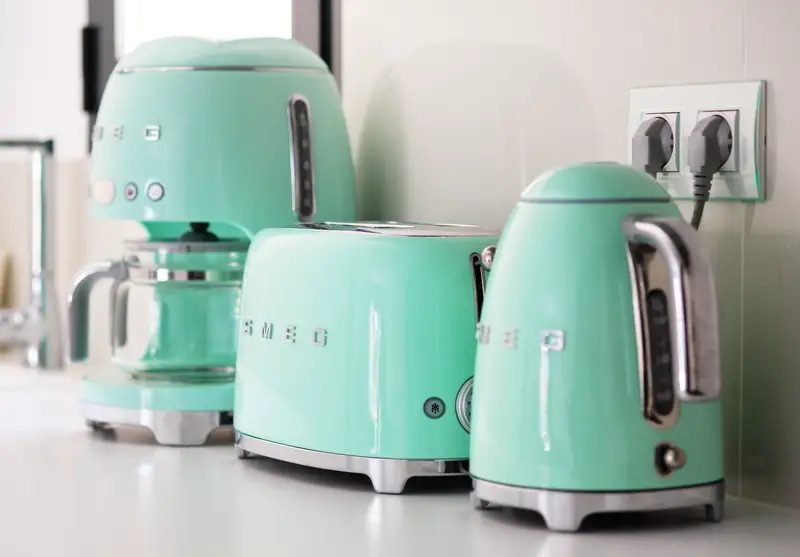Ever come home from vacation to find your house still standing, but with a nagging feeling you forgot something important? Most people remember to lock doors and set alarms, but they completely ignore one of the biggest fire risks sitting right on their kitchen counter. That innocent-looking toaster could be plotting against your home while you’re sipping drinks on the beach, and it’s not the only appliance with sneaky intentions.
Your toaster is a fire hazard waiting to happen
That toaster sitting on your counter isn’t as harmless as it looks. All those crumbs from your morning bread routine pile up inside, creating the perfect fire starter. Even when it’s not toasting anything, electricity still flows through the wires, and if something goes wrong with the internal parts, those crumbs can catch fire faster than you’d expect. Fire experts consistently name toasters as one of the most overlooked fire risks in kitchens.
The scary part is that toaster fires can start even when the device feels completely cool to the touch. Damaged wiring or loose connections can create electrical arcs that generate enough heat to ignite built-up debris. Professional electricians see this problem regularly, and they all give the same advice: unplug your toaster every single time you finish using it, especially before leaving town for any extended period.
Coffee makers cause more problems than you think
Most people assume their coffee maker is perfectly safe when it’s turned off, but that’s not really true. These machines have heating elements and water reservoirs that can malfunction in ways that create serious fire risks. If a heating element gets stuck in the “on” position or if there’s an electrical short, your coffee maker could overheat and start a fire while you’re thousands of miles away enjoying your vacation.
The water aspect makes coffee makers even more dangerous than other small appliances. If something goes wrong with the internal mechanisms, water can leak onto electrical components, creating the perfect conditions for electrical fires or even explosions. This combination of heat, electricity, and water makes coffee makers a triple threat that smart homeowners always unplug before traveling. Don’t let your morning caffeine habit turn into a homecoming nightmare.
Electric kettles can overheat without warning
Electric kettles might seem like simple devices, but they’re actually sophisticated appliances with multiple failure points. The automatic shut-off feature that’s supposed to turn off the kettle when water boils can malfunction, leaving the heating element running indefinitely. If there’s no water in the kettle when this happens, the metal can get hot enough to warp, crack, or even ignite nearby materials. This type of failure is more common than most people realize.
Unlike stovetop kettles that need someone to turn on the burner, electric kettles can theoretically activate themselves if there’s an electrical problem. Power surges, faulty switches, or damaged cords can cause these appliances to turn on unexpectedly. When nobody’s home to notice the problem, an electric kettle can literally boil itself dry and keep heating until something catches fire. That’s why fire safety experts put electric kettles at the top of their “must unplug” lists.
Hair styling tools stay hot longer than expected
Hair dryers, curling irons, and straighteners are designed to get extremely hot, and they can stay dangerous long after you think they’ve cooled down. These tools often have internal heating elements that can malfunction and start heating up again hours after you last used them. If you toss a hair tool into a drawer or leave it on a counter near papers, towels, or other flammable materials, you’re creating a fire risk that could activate while you’re sleeping or away from home.
Many hair straighteners and curling irons don’t have reliable automatic shut-off features, even though manufacturers claim they do. These safety mechanisms can fail or get bypassed by electrical problems, leaving your styling tools heating up indefinitely. Professional hair stylists know this risk well and always unplug their tools completely when closing up shop. The same precaution makes sense for anyone leaving home for more than a few hours.
Small space heaters are bigger risks than people realize
Portable heaters cause thousands of house fires every year, and many of these incidents happen when nobody’s home to spot the warning signs. Even small desktop heaters or bathroom warming units can overheat if their internal fans stop working or if dust builds up around the heating elements. These compact devices often get forgotten in corners or under desks, where they can overheat without anyone noticing until it’s too late.
The biggest problem with space heaters is that people underestimate how much electricity they draw and how hot they actually get. A heater that seems perfectly safe during normal use can become a fire hazard if it’s left plugged in and something triggers it to turn on unexpectedly. Power fluctuations, faulty thermostats, or damaged switches can cause these devices to activate and overheat when there’s nobody around to turn them off or move flammable objects out of the way.
Phone chargers and power strips multiply the danger
That tangle of phone chargers, tablet cords, and power strips might look harmless, but it’s actually a fire hazard network waiting for the right conditions to cause problems. Cheap chargers especially can overheat, spark, or even explode when left plugged in for extended periods. The plastic housings on these devices can melt and catch fire, and when multiple chargers are plugged into the same power strip, the fire risk multiplies significantly.
Power strips create additional risks by concentrating multiple electrical devices in one location. If one device in the strip malfunctions and catches fire, it can quickly spread to all the other connected gadgets. Power strips themselves can also fail, especially cheaper models that don’t have proper surge protection or circuit breakers. Fire investigators regularly find that house fires started with overloaded or malfunctioning power strips that nobody thought to unplug before leaving home.
Air fryers and toaster ovens accumulate dangerous grease
Air fryers have become incredibly popular, but they’re also becoming a more common cause of kitchen fires. These devices cook food at high temperatures and can accumulate grease and food particles that become fire hazards over time. If an air fryer malfunctions and gets stuck heating, all that built-up grease can ignite and create a serious fire that spreads quickly through the kitchen.
Toaster ovens present similar risks but are even more dangerous because they’re larger and often used more frequently than regular toasters. The combination of heating elements, accumulated food debris, and grease makes these appliances particularly risky when left plugged in during extended absences. Air fryers and toaster ovens both have complex electrical systems that can fail in ways that cause them to overheat unexpectedly, making them prime candidates for unplugging before any trip.
Candle warmers and wax melters never really turn off
Candle warmers and wax melting devices are designed to stay warm for hours at a time, which makes them especially dangerous when left unattended. These devices maintain constant heat that can easily ignite nearby papers, curtains, or other flammable materials if something goes wrong. Many people forget these devices are even plugged in because they operate so quietly and don’t have obvious on/off indicators.
The wax itself can become a fire hazard if the warmer overheats or tips over. Hot wax can ignite and spread fire quickly across surfaces, and many candle warmers don’t have automatic shut-off features that work reliably. These devices are specifically designed to operate for long periods without supervision, but that same feature makes them dangerous when left plugged in during vacations. The constant heat combined with the flammable wax creates a fire risk that smart homeowners eliminate by unplugging these devices completely.
Even vampire electronics can cause expensive problems
Electronics that draw power even when they’re turned off might not seem like fire risks, but they can still cause problems that cost money and create safety concerns. These “vampire” devices continue pulling electricity 24 hours a day, running up utility bills unnecessarily when nobody’s home to benefit from their standby functions. More importantly, any device that’s constantly drawing power has the potential to malfunction and overheat.
Gaming consoles, cable boxes, and sound systems all fall into this category of devices that never truly shut off. While they’re less likely to cause fires than heating appliances, they can still experience electrical failures that damage the devices themselves or cause power surges that affect other electronics in the home. Surge protectors offer some protection, but the safest approach for vacation travel is to unplug non-essential electronics entirely. This eliminates both the fire risk and the unnecessary energy costs that add up over time.
Taking a few minutes to unplug dangerous appliances before leaving town is one of the smartest things any homeowner can do. The peace of mind alone is worth the small effort, and the potential savings in avoided fire damage, insurance claims, and energy costs make this simple precaution a no-brainer for anyone who travels regularly.

